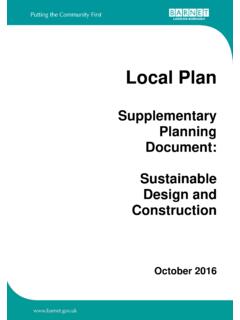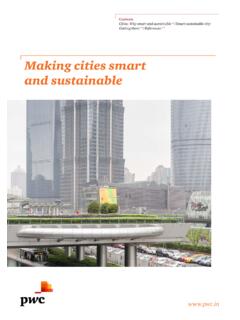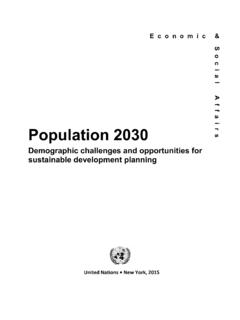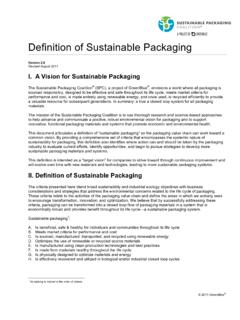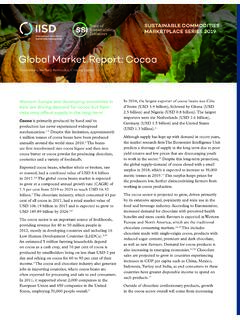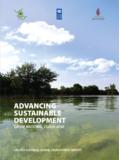Transcription of GRID INTEGRATION OF WIND POWER - Asian …
1 Asian development BANKASIAN development BANK6 ADB Avenue, Mandaluyong City1550 Metro Manila, INTEGRATION OF wind POWERBEST PRACTICES FOR emerging wind MARKETSP ramod Jain and Priyantha WijayatungaADB sustainable development WORKING PAPER SERIES NO. 43 April 2016 grid INTEGRATION of wind PowerBest Practices for emerging wind MarketsIssues with grid INTEGRATION of wind energy has led to curtailment of wind POWER , delay in interconnection for commissioned wind projects and/or denial of generation permit. This report describes the impact of wind POWER on the grid , methods to analyze the impact and approaches to mitigate the impact. Countries like Denmark, Germany, Spain, and regions within the United States like Texas and Colorado have achieved high penetration of wind energy with modest changes to the grid .
2 The key to high penetration of wind energy has been flexible grids. The report outlines the lessons learned with a focus on applicability to emerging wind energy the Asian development BankADB s vision is an Asia and Pacific region free of poverty. Its mission is to help its developing member countries reduce poverty and improve the quality of life of their people. Despite the region s many successes, it remains home to the majority of the world s poor. ADB is committed to reducing poverty through inclusive economic growth, environmentally sustainable growth, and regional in Manila, ADB is owned by 67 members, including 48 from the region. Its main instruments for helping its developing member countries are policy dialogue, loans, equity investments, guarantees, grants, and technical sustainable development Working Paper Series grid INTEGRATION of wind POWER : Best Practices for emerging wind Markets Pramod Jain and Priyantha Wijayatunga No.
3 43 | April 2016 Priyantha Wijayatunga is principal energy specialist, sustainable development and Climate Change Department, Asian development Bank (ADB). Pramod Jain is the president of Innovative wind Energy and consults with ADB under the Quantum Leap in wind development for Asia and the Pacific Technical Assistance program. Creative Commons Attribution IGO license (CC BY IGO) 2016 Asian development Bank 6 ADB Avenue, Mandaluyong City, 1550 Metro Manila, Philippines Tel +63 2 632 4444; Fax +63 2 636 2444 ; Some rights reserved. Published in 2016. Printed in the Philippines. Publication Stock No. WPS167996-2 Cataloging-In-Publication Data Asian development Bank. ADB sustainable development Working Paper Series No. 43: grid INTEGRATION of wind POWER : Best Practices for emerging wind Markets.
4 Mandaluyong City, Philippines: Asian development Bank, 2016. 1. wind energy. 2. Renewable energy. I. Asian development Bank. The views expressed in this publication are those of the authors and do not necessarily reflect the views and policies of the Asian development Bank (ADB) or its Board of Governors or the governments they represent. ADB does not guarantee the accuracy of the data included in this publication and accepts no responsibility for any consequence of their use. The mention of specific companies or products of manufacturers does not imply that they are endorsed or recommended by ADB in preference to others of a similar nature that are not mentioned. By making any designation of or reference to a particular territory or geographic area, or by using the term country in this document, ADB does not intend to make any judgments as to the legal or other status of any territory or area.
5 This work is available under the Creative Commons Attribution IGO license (CC BY IGO) By using the content of this publication, you agree to be bound by the terms of said license as well as the Terms of Use of the ADB Open Access Repository at This CC license does not apply to non-ADB copyright materials in this publication. If the material is attributed to another source, please contact the copyright owner or publisher of that source for permission to reproduce it. ADB cannot be held liable for any claims that arise as a result of your use of the material. Attribution In acknowledging ADB as the source, please be sure to include all of the following information: Author. Year of publication. Title of the material. Asian development Bank [and/or Publisher]. Available under a CC BY IGO license.
6 Translations Any translations you create should carry the following disclaimer: Originally published by the Asian development Bank in English under the title [title] [Year of publication] Asian development Bank. All rights reserved. The quality of this translation and its coherence with the original text is the sole responsibility of the [translator]. The English original of this work is the only official version. Adaptations Any adaptations you create should carry the following disclaimer: This is an adaptation of an original Work Asian development Bank [Year]. The views expressed here are those of the authors and do not necessarily reflect the views and policies of ADB or its Board of Governors or the governments they represent. ADB does not endorse this work or guarantee the accuracy of the data included in this publication and accepts no responsibility for any consequence of their use.
7 Please contact or if you have questions or comments with respect to content, or if you wish to obtain copyright permission for your intended use that does not fall within these terms, or for permission to use the ADB logo. Note: In this publication, $ refers to US dollars. CONTENTS TABLES AND FIGURES iv ABBREVIATIONS v EXECUTIVE SUMMARY vi I. INTRODUCTION 1 II. WHAT IS UNIQUE ABOUT INTEGRATING wind ENERGY? 4 A. Variable POWER 4 B. Uncertain POWER 4 C. Geographic Diversity, Size, and Distance from Load 4 D. Standardized POWER Purchase Agreement with Guaranteed Interconnection and Priority Dispatch 5 E. wind Turbine Generators 6 III. WHAT IS grid INTEGRATION OF wind ENERGY? 6 A. Planning 7 B. Physical Connection 8 C. System Operations 9 IV. WHAT IS THE IMPACT OF A wind POWER PLANT ON A grid ?
8 9 A. Day-Ahead Unit Commitment Process 9 B. Economic Dispatch Process 9 C. Illustration of Variability and Uncertainty of wind Energy 10 D. Implications of wind Energy on Conventional Generators and Transmission 10 V. BEST PRACTICES FOR wind INTEGRATION IN emerging MARKETS 11 A. Transmission from Resource-Rich Areas to Load Center 12 B. Responsive System Operations 12 VI. HOW MUCH DOES grid INTEGRATION COST? 15 VII. CONCLUSIONS 18 APPENDIX I: SYSTEM IMPACT STUDIES 20 APPENDIX II: CHECKLIST FOR REQUIREMENTS FOR INTERCONNECTING VARIABLE GENERATION 24 REFERENCES 25 TAB LE S AND FIGURES Ta b l e s 1 Common Myths about grid INTEGRATION of wind Energy 2 Figures 1 Plot of Net Load for 1 Week 3 2 High-Level Activities of grid INTEGRATION 6 3 Tiered Planning for grid INTEGRATION 15 4 Studies on wind INTEGRATION Costs versus wind Capacity Penetration in Various Regions of the United States 16 5 Relative Cost of Various Options to Increase Flexibility of the grid with Varying wind Percentages 17 ABBREVIATIONS ADB Asian development Bank FiT feed-in tariff GW gigawatts MW megawatts MWh megawatt-hour POI point of interconnection VRE variable renewable energy WPP wind POWER plants WTG wind turbine generators vi
9 Executive Summary EXECUTIVE SUMMARY Utility-scale wind energy is the most inexpensive form of renewable energy in countries with good wind resources. Globally, wind POWER has experienced rapid growth of 25% annually, from gigawatts (GW) in 2000 to 370 GW in 2014. Growth in Asia has been limited to the People s Republic of China and India. As of end of 2014, the former had GW, which is 31% of the global installed wind capacity, while India had GW, for a share. Other Asian countries like Pakistan, the Philippines, and Thailand have seen a growth spurt in 2013 and 2014. The Quantum Leap in wind POWER development for Asia and the Pacific program of the Asian development Bank (ADB) has been providing technical assistance for close to 5 years to three emerging wind energy countries Mongolia, the Philippines, and Sri Lanka.
10 This study reports observations and experiences in these and other emerging wind energy markets. In emerging wind energy markets, issues related to grid INTEGRATION of wind energy are not at the forefront. grid INTEGRATION is approached on an ad hoc, project-by-project basis. Project-specific grid INTEGRATION components like transmission, substation, and physical connection are built in order to transport wind energy from a wind POWER plant (WPP) to load centers. Beyond this obvious component, all other grid INTEGRATION components are ignored until after the WPP is online and issues start to emerge like POWER quality (harmonics), voltage fluctuations, congestion, and curtailment. There is also a pervasive notion among grid operators that their specific grid is unique and there is not much that can be learned from other grid operators, especially from developed wind energy markets.











